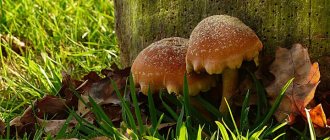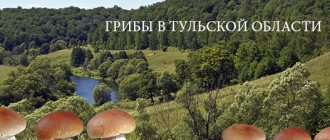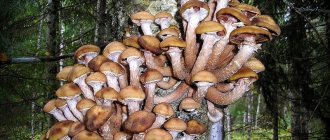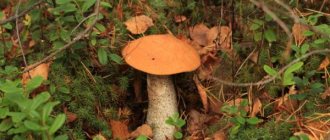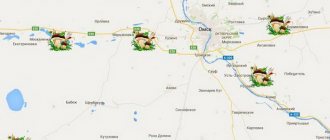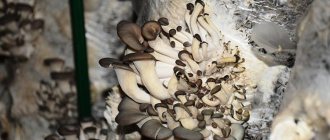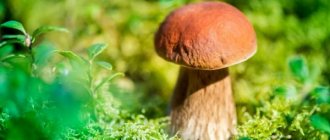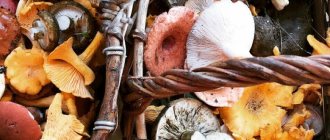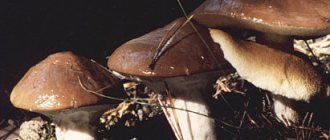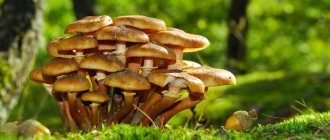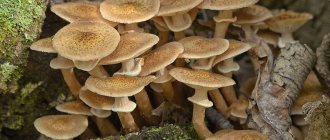Mushrooms
1
4475
Article rating
Kira Stoletova
The Vladimir region is located in the European part of Russia. Thanks to the good climate and peculiarities of the region, mushrooms in the Vladimir region will actively bear fruit in 2022.
Types of mushrooms in the Vladimir region in 2019
Mushrooms in the Vladimir region
The Vladimir region is located in the European part of Russia. Thanks to the good climate and peculiarities of the region, mushrooms in the Vladimir region will actively bear fruit in 2022. Since this region is located in the north of the country, its main feature is its abundant forest cover. Forests make up 50.7% of its entire territory. Most of them are mixed plantings.
The region has flat steppe terrain, so wild species also grow here. The east and south of the region are considered mushroom. There are few forests in the north, so people rarely go there for “silent hunting,” but local residents say that they find tasty mushrooms there too.
Mushroom places of the Vladimir region.
What mushrooms can already be collected in the forests of the Moscow region now?
The long spring, which this year began in February, has led to real mushroom eccentricities. In the forests of the Moscow region, spring and autumn seem to be mixed. There is no other way to explain how local mushroom pickers can gather spring delicacies into one basket, such as morels, strings and autumn boletuses, boletus and boletus. In the second half of May, granular boletus appeared in the forests, which previously could only be found after the first warm thunderstorms, in the very heat.
This year, in May, you can also pick up autumn oilseeds, which are called late oilseed or autumn. Together with their summer brothers, boletus produced an unprecedented amount of “harvest”, which is not typical for this time of year. The greatest decline in boletus was observed in the Eastern, South-Eastern and Southern regions of the Moscow region. Almost simultaneously with boletus mushrooms, boletus mushrooms appeared. And since these mushrooms, like boletus, usually appear in November, an atmosphere of endless autumn is created in the forests of the Moscow region.
Edible and conditionally edible mushrooms
In different types of plantings you need to look for the following plants:
- In old forests there are saffron milk caps.
- In young pine plantations there are boletus.
- In deciduous forests there are boletus mushrooms, porcini mushrooms, aspen mushrooms, boletus mushrooms, and boletus mushrooms.
- In mixed forests there are russula, chanterelles and moss mushrooms.
Champignons and honey mushrooms are found less often. The following species are considered tasty when properly processed and salted:
- milk mushroom;
- wave;
- value;
- bitter;
- row;
- pushers;
- violins.
They are soaked in water for several days and boiled in boiling water for 15 minutes. Previously edible pigs are now considered poisonous. In the south of the region, mushrooms start growing in early spring. They collect morels and early honey mushrooms. Since mid-June, butter mushrooms, porcini mushrooms, fly mushrooms, honey mushrooms, and russula have been growing. They reach the peak of their meatiness and abundance from the end of August to the end of September. At the same time, boletuses, boletus, boletus, and saffron milk caps are collected.
View recipes:
Salted and pickled mushrooms, preservation and preparations
View recipes:
Mushroom dishes: festive and everyday
How to assemble and cook correctly
We collect them when the mushroom cap is almost completely open and looks like an umbrella. I don’t like the leg: it’s fibrous and tough. Although you can dry it, then grind it in a coffee grinder and add mushroom powder to the soup - the aroma is simply divine! The caps also make a very tasty soup, but most of all I like to fry them.
I separate the cap from the stem, wash it and clean it of the dark scales on top. Then the umbrellas should be lightly dried with a towel, otherwise they will not cook well. I cut each cap into 4 pieces and fry them in a lot of oil, because I like them crispy. And before frying, I roll the mushrooms on both sides in flour with salt and spices. They taste like fish, although there is no fishy smell.
White umbrella caps sometimes bloom up to 15 centimeters in diameter. Photo: na-dache.pro
If you want a juicier dish, then fry the mushrooms in batter. That is, dip the cut umbrellas in a mixture of egg and flour and fry in oil at high speed. And for a very short time! If ordinary mushrooms have to be pre-soaked, boiled, skimmed off the broth and only then fried, then it is enough to hold the umbrellas in a hot frying pan with oil for two minutes on each side. And it turns out to be a delicious dish!
This mushroom contains both vitamins and substances that prevent the growth of tumor cells.
Pizza with umbrellas is good, as is solyanka. And everything cooks much faster than with other mushrooms, because no pre-cooking is needed. Moreover, fried umbrellas are much tastier than white or chanterelles. And the small champignons taste the same.
The most mushroom places
The Vladimir region consists of 16 districts, each of which has its own representatives of the mushroom kingdom. The most mushroom places in the Vladimir region in 2022 are the following:
- Alexandrovsky district - boletus, boletus, aspen.
- Yuryev-Polsky district - boletus, white.
- Suzdal region - boletus, boletus, chanterelle and boletus.
- Kameshkovsky district - boletus, boletus.
- Kovrovsky - boletus, boletus, boletus.
These areas belong to the northern part of the Vladimir region. These areas are not recommended for amateurs. Here, mushroom harvests are not so abundant, and local residents have long known all the mushroom places.
Southern part of the Vladimir region
The Gus-Khrustalny and Melenkovsky districts are rich in:
- White mushroom;
- chanterelles;
- boletus;
- boletus.
The climate here is mild, so mushroom picking begins in early spring until the first snow. These places are popular among mushroom pickers in the autumn season.
West
In the west of the Vladimir region, mushroom picking can be carried out in:
- Kirzhachsky;
- Petushinsky;
- Kolchuginsky districts.
Central regions
Sobinsky and Sudogodsky districts are famous for porcini mushrooms, aspen mushrooms, and boletus mushrooms. You should not pick mushrooms near highways and roads due to the high content of toxic substances in the mushroom.
East End
The eastern regions include:
- Selivanovsky;
- Vyaznikovsky;
- Gorokhovetsky;
- Muromsky.
They are rich in chanterelles and porcini mushrooms. There are also a lot of conditionally edible mushrooms in these parts. Some of them are considered the most fungal:
- Vyaznikovsky;
- Melenkovsky;
- Selivanovsky;
- Sobinsky.
The poorest are Petushinsky and Yuryev-Polsky districts.
People have their own mushroom places, these are:
- vicinity of the village of Sushnevo.
- forest of the Orgtrud microdistrict.
- pine forest in Baigushi.
- Shepelevo forest.
- Moshok forests.
During the collection period, you should be careful: there are snakes and wild animals in the Vladimir forests. It is also important to watch out for swamps.
The Vladimir region is rich in forests, so it is recommended for collecting mushrooms, especially in autumn. According to official forestry data, the best areas for collection are Vyaznikovsky, Melenkovsky, Selivanovsky. Porcini mushrooms, boletuses, chanterelles, saffron milk caps and boletus are common here. The main thing during collection is not to confuse the edible fruiting bodies of different types of mushrooms with poisonous ones.
Read more:
Where to donate excess mushrooms
Read more:
The earliest spring mushrooms
Read more:
How to distinguish an edible mushroom from an inedible one
Poisonous mushrooms
Poisonous mushrooms are very dangerous
The most dangerous poisonous fruits are counterparts of edible species:
- Pale toadstools disguise themselves as mushrooms.
- The gall mushroom looks like boletus.
- False honey mushrooms and chanterelles are dangerous.
- Beginning mushroom pickers confuse russula with red fly agaric (if heavy rains wash away white flakes from the surface of the cap - the remains of the cover).
In the toadstool, the leg expands into a tuber-like base, and the plates lighten with age.
The gall fungus turns pink when scrapped, it is never attacked by worms, and insects do not land on top.
False honey mushrooms do not have a ring on the stem. They have gray-green or gray plates. The poisonous chanterelle secretes milky juice at the break. The poisonous counterpart of russula has a ring on the stem, and there are tubercles or specks on its cap (not always white).
Often, conditionally edible fruits have dangerous varieties. The gray-pink milkweed looks like a white milk mushroom. False valui (or horseradish mushroom) are dangerous.
Irina Selyutina (Biologist):
Of the representatives of the genus Cobwebs, the greatest danger to humans is, perhaps, false valui, or adhesive hebeloma, or as it is popularly called, horseradish mushroom. It very much resembles russula in appearance, but is radically different from them in its chemical composition. The main distinguishing feature is the pungent odor of horseradish, which is emitted by freshly cut fruiting bodies. You shouldn’t put it in your basket to study it in more detail at home - after a while the smell will disappear and it will no longer be possible to determine “who is who.” The first signs of poisoning appear within 10 minutes after “eating” the mushroom. Severe thirst develops, turning into vomiting, and it becomes difficult for a person to breathe. It is necessary to urgently call an ambulance, and before that, begin gastric lavage.
Today it is known that in the fruiting body of the fungus there are two groups of toxins that are complex in structure, but it is difficult to say which ones they are. Therefore, there is no need to talk about antidotes. Scientists agree on one thing:
Group 1 of toxins is characterized by a curare-like effect. This means that the victim may develop asphyxia and paralysis of the skeletal muscles of the chest responsible for respiratory processes. Then comes the turn of the respiratory center in the brain. He supervises the “inhale-exhale” sequence and after 20-30 minutes the person dies.
Group 2 toxins provoke paralysis of nerve cells, which leads to darkening of the eyes, dry mouth, severe headaches and paralysis of the limbs.
Poisonous talkers, unlike edible ones, have a pleasant powdery smell of pulp.
Mushroom places of the Vladimir region
The Vyaznikovsky forestry competently suggested that there are now a lot of mushrooms in the lowlands and mainly in the south of the Vladimir region. In other places, during growth, the mushrooms were slightly lacking in moisture. The best places were discovered in the Vladimir forestry enterprise. Now you need to look for mushrooms in the Sudogodsky district, near Raduzhny. A very good mushroom place near the village of Moshok in the Muromsky district. Now is the time for chanterelles and boletus - they are found in almost every area. The table shows points for the number of mushrooms.
| Area | Mushrooms | Number of mushrooms (on a 5-point scale) |
| Alexandrovsky | boletus, boletus, boletus | 3 |
| Vyaznikovsky | boletus, boletus, chanterelles, boletus, porcini mushrooms | 5 |
| Gorokhovetsky | boletus, chanterelles, porcini mushrooms, boletus | 4 |
| Gus-Khrustalny | boletus, boletus, chanterelles, porcini mushrooms | 3 |
| Kameshkovsky | boletus, boletus | 3 |
| Kirzhachsky | chanterelles, boletus | 3 |
| Kovrovsky | boletus, boletus, boletus | 3 |
| Kolchuginsky | boletus, chanterelles, russula | 3 |
| Melenkovsky | chanterelles, boletus, boletus | 5 |
| Muromsky | boletus, porcini mushrooms, boletus | 4 |
| Petushinsky | boletus, saffron milk caps, chanterelles | 1 |
| Selivanovsky | chanterelles, boletus | 5 |
| Sobinsky | porcini mushrooms, boletus, boletus | 5 |
| Sudogodsky | boletus, boletus, boletus, chanterelle | 4 |
| Suzdal | boletus, porcini mushrooms, boletus, chanterelles | 3 |
| Yuriev-Polsky | boletus, porcini mushrooms | 2 |
Real reviews with photos
Before going into the forest to pick mushrooms, experienced mushroom pickers always study third-party opinions about the beginning of fruiting. The conclusion can be drawn based on truthful reviews left in the VK and Odnoklassniki communities, as well as on the pages of the mushroom forum dedicated to collecting protein-rich forest products. Information from the photo will allow you to determine what mushrooms can be collected today: chanterelles or honey mushrooms, rows or russula, boletus and saffron milk caps or hygrophora and spruce mushrooms, milk mushrooms, talkers and even noble varieties.
Regardless of whether the mushroom picker manages to collect full baskets of mushrooms or just a few for frying, the new crop will sprout again, delighting the next guests who come to the forest thicket for the gift.
You can find the gifts of the forest in any “green” place where there is fertile soil and clean air. Regardless of the variety, most edible mushrooms cleverly disguise themselves as the fauna of the place of germination, merging, if not with yellow-brown foliage, then with stones and pine sawdust.
Mushroom picking in 2022, mushroom picker calendar and video
Hi all! Mushroom picking in the 2022 calendar and a new video in this material. The mushroom season begins in spring and ends in September or October. With the onset of autumn, the world around us transforms and changes its shades. This is especially noticeable in the autumn forest.
Walking along forest paths, you can be completely satisfied with the variety of colors that nature itself generously gifts us with. Among the three months of autumn, October stands out as bright. It is not so warm, but on sunny days all the trees in the forest glow with gold.
A walk in the forest can be useful if desired. Among the fallen leaves you can see a mushroom trying to hide. Autumn is the period of mushroom picking. There is a place to have a blast and stock up on mushrooms for the winter. In our article about mushroom picking 2022 with a new video.
Many people don't know when and where to pick mushrooms!
Mushroom picker calendar 2019
The decisive factor for the appearance of mushrooms in the forest is not the numbers on the calendar, but the weather conditions, and not even those that are observed at the moment, but specifically those that were observed before. After a long winter with heavy snow or after a dry summer, mushrooms do not appear at the same time as after a warm winter or wet summer.
The most important factors for the growth of mushrooms - both in terms of period and in terms of their quantity - are humidity and temperature. But generally speaking, those years when the amount of precipitation exceeds average norms turn out to be much more beneficial for mushrooms than dry ones.
How to pick mushrooms in the forest
A brief reminder of the rules for collecting mushrooms is as follows:
- In any case, resolutely throw away unfamiliar mushrooms, even if you have even the slightest doubt, remember that even one questionable fungus can cost you your life.
- For the first time or with little experience, go to the forest with experienced mushroom pickers who are familiar to you personally, use reference books.
- Following the basic rules, mushroom picking should be carried out in environmentally friendly places, away from cities and large industrial enterprises, at a distance of at least 500 meters from highways.
- Do not take old mushrooms or specimens with even slight signs of mold.
- Mushrooms should be harvested, preserved and stored according to the recipes of experienced specialists.
- Never buy mushrooms from unknown sellers or in the absence of an officially registered store.
Go to the forest in thick, closed clothing, always with a hat, use mosquito and tick repellent, shake out your clothes after a walk in the forest, consult a doctor immediately if you find ticks on your body (in some areas ticks are not encephalitic and at the first sign of poisoning fruiting bodies. If the cut mushroom turns out to be wormy, do not throw it on the ground, but rather prick it on a twig or twig. When the mushroom dries, its spores will be carried by the wind throughout the forest.
What mushrooms appear in spring
- March is the least mushroom month. Things are tough with mushrooms.
- April - morels and some other mushrooms appear, a new mushroom season begins.
- May - there are even more mushrooms, the most interesting are the May mushroom (aka St. George's mushroom) and boletus, as well as other spring-summer mushrooms.
What mushrooms grow in summer
- June - in the second half of the month porcini mushrooms, aspen mushrooms, boletus mushrooms, boletus mushrooms appear...
- July is a diverse month in terms of mushroom species but not particularly abundant in terms of yield.
- August is the beginning of the third mushroom layer; there are more than 120 species and varieties of edible mushrooms alone!
What mushrooms are collected in the fall?
- September is the peak of the mushroom season, the real “harvest”, preparations for the winter
- Is October the end of the season? Perhaps yes. But not for everyone!
- November is a very interesting month in terms of the species composition of mushrooms. In November you can simultaneously find mushrooms from all four seasons of the year.
Mushrooms growing in the forest in winter
- December – late remnants of autumn mushrooms, as well as oyster mushrooms, winter honey mushrooms
- January - when else should the winter mushroom (flammulina) grow if not in January?
- February – closing of the mushroom season: winter honey mushrooms, Judas’s ear.
Dubious mushrooms
Even the youngest mushroom picker knows that there are species that should not be eaten. In appearance, they may look completely edible, but inside they have poisonous substances.
That’s why the rules for picking mushrooms include the following point: under no circumstances take questionable mushrooms. If you have even the slightest doubt about the edibility of a mushroom, it is better to leave it on the ground. Try to avoid mushrooms that are too old, soft or wormy.
They are also considered poisonous. The harmful substance in them is formed due to the presence of bacteria. If we talk a little about the ranking of poisonous mushrooms, then, without a doubt, the first place is occupied by the pale toadstool, followed by the stinking fly agaric and the white fly agaric.
Poisonous mushrooms taste bitter and have an unpleasant odor. So remember, hunting, even a “quiet” one, can bring trouble if you put everything in the basket indiscriminately.
The following types of mushrooms are among the most dangerous to human life and health:
- pale grebe, found from the first ten days of August until the end of September;
- false chanterelle or orange talker, found from the first ten days of July to mid-October;
- false honey fungus, which occurs from the first days of summer until mid-October;
- the toadstool fly agaric, found from the middle of the last summer month to mid-September;
- satanic mushroom, found from the first days of summer until the onset of a steady autumn cold snap;
- Russula is pungent and pungent, found from mid-summer to mid-autumn;
- gray-pink laticifer, found from the last ten days of summer until the onset of steady autumn cooling;
- red trellis, growing in forests from the last ten days of spring until the onset of autumn;
- beautiful gymnopilus, growing from the last ten days of the first summer month until mid-September;
- Valui false, growing from the first ten days of the last summer month until the end of September.
Rules for eating mushrooms
Mushrooms are not recommended for consumption by children under 7 years of age, pregnant women, patients with ulcers, or kidney failure.
Before eating, mushrooms must be thoroughly washed and cooked for 15-25 minutes.
Signs of food poisoning are:
- dyspeptic disorders;
- dizziness;
- headaches;
- pain in the stomach;
- hallucinations;
- impaired coordination of movements.
Symptoms appear within the first 24 hours after toxins enter the body. To cleanse, doctors recommend inducing vomiting before the ambulance arrives. To do this, drink 1-1.5 liters of water or a weak solution of potassium permanganate in 1-2 approaches.
Treatment of intoxication is carried out with the help of sorbents, and then drugs to restore healthy microflora. Symptomatic therapy is also carried out. In case of severe poisoning, prolonged vomiting and diarrhea, emergency medical attention is required. A poisoned person is advised to drink water from a spoon to prevent dehydration.
Mushroom picking in 2022 new video
How to grow mushrooms yourself? Read this link!
Where to buy mushroom mycelium, seeds and seedlings with delivery
Mushroom picking in 2022, mushroom picker calendar and video.
Source: //vsem-privet.ru/sbor-gribov-v-2019-godu/
And fly mushrooms are good in marinade
And for pickles, in addition to the usual saffron milk mushrooms and white mushrooms, we collect moss mushrooms on occasion. They look as strong as a porcini mushroom; the caps are brown and suede on top, and greenish and tubular on the inside. These mushrooms grow in pine forests, and when pickled, like butter mushrooms, they are “snotty” and very tasty. But moss mushrooms are not suitable for soup: the broth turns out to be very dark!
The moss mushrooms are as strong as a porcini mushroom; the caps are brown and suede on top, and greenish and tubular on the inside. Photo: mycoweb.ru
But they are very nice to collect. If you still have to run for the same umbrellas, then you don’t need to go much here. When it’s a mushroom year, there’s just a sea of moss mushrooms. You walk, and they go around, around, around...
